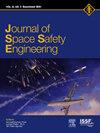Infrared photometry and spectrometry of satellites and debris at UKIRT
IF 1.7
Q3 ENGINEERING, AEROSPACE
引用次数: 0
Abstract
The characterization of deep space debris poses a significant challenge in Space Domain Awareness (SDA). Multi-color photometry and the resultant color indices offer the potential to rapidly discriminate between debris and intact space objects such as rocket bodies and satellites. These multi-color techniques can also identify anomalous members of objects in certain groups and cue higher fidelity data collections and studies. However, multi-color photometry can be difficult to interpret, as the effects of phase and rotation become conflated with the more fundamental material properties of the satellite. Additionally, the broad astronomical photometric bands may not identify key spectral features that can be diagnostic for SDA applications. With our recent observational campaign we have been able to collect 5-color photometry in the near-IR with WFCAM as well as overlapping near-IR spectra with the UKIRT 1–5 μm Imager-Spectrometer (UIST). On a small set of objects, we also have mid-IR spectrophotometry with the Mid-IR esCHELLE (Michelle) imaging spectrograph.
Our previous measurements with the United Kingdom Infrared Telescope (UKIRT) Wide Field Camera (WFCAM) characterized a wide range of space objects with the goal of developing techniques to rapidly discriminate between different classes of objects and to identify anomalous members of these groups. The survey has produced a comprehensive database of 5-color photometry in the Z, Y, J, H, and K bands, analogous to the bands that are anticipated to be exploited by future U.S. ground-based SDA systems. Our current data set includes:
- (a)United States Centaur rocket bodies (RBs),
- (b)Molniya communication satellites including the −1 K, 1T, −2, and −3 variants,
- (c)Russian FREGAT and SL-6 upper stage RBs in Molniya orbits,
- (d)Russian Breeze-M rocket bodies disposed of in GEO-crossing graveyard like orbits, and the Angara-5/Breeze-M mass simulator, also disposed of in a near-GEO orbit,
- (e)Intact payloads selected from satellites using the Boeing HS-376 buses—including four different generations of solar panel technology.
英国红外辐射计对卫星和碎片的红外测光和光谱分析
深空碎片的特征描述是空间领域意识(SDA)中的一项重大挑战。多色光度法和由此产生的色彩指数为快速区分碎片和完整的空间物体(如火箭体和卫星)提供了可能。这些多色技术还能识别某些组中物体的异常成员,并提示更高保真的数据收集和研究。不过,多色光度测量可能难以解释,因为相位和旋转的影响会与卫星更基本的物质特性混为一谈。此外,宽泛的天文测光波段可能无法识别关键光谱特征,而这些特征对 SDA 应用具有诊断作用。在最近的观测活动中,我们利用 WFCAM 收集了近红外五色光度,并利用英国红外热像仪 1-5 μm 成像光谱仪(UIST)收集了重叠的近红外光谱。我们以前利用英国红外望远镜(UKIRT)宽视场照相机(WFCAM)测量了大量空间物体,目的是开发快速区分不同类别物体的技术,并识别这些物体群中的异常成员。这次调查建立了一个全面的数据库,其中包括 Z、Y、J、H 和 K 波段的五色测光数据,这些波段类似于美国未来地面 SDA 系统预计使用的波段。我们目前的数据集包括(a)美国半人马座火箭体(RB),(b)闪电号通信卫星,包括-1 K、1T、-2 和-3 变体,(c)闪电号轨道上的俄罗斯 FREGAT 和 SL-6 火箭末级 RB,(d)在类似地球同步轨道的墓地轨道上弃置的俄罗斯微风-M 火箭体、(e)从使用波音 HS-376 总线(包括四代不同的太阳能电池板技术)的卫星上选取的完好有效载荷。我们研究的许多天体在地球同步轨道带上都有明显的轨道倾角或漂移。对这些天体的光度测量进行解释尤其困难,因为相位角不再能被简单地视为一个单一维度的量。在 2023 年期间,我们努力扩大了对少数几个天体的相位角覆盖范围,并对相位角两个分量的亮度和颜色进行了全面采样。在本文中,我们展示了 "相位-相位 "示意图,演示了这一技术,并着重介绍了在实现全面相角覆盖和解释这些结果时遇到的一些实际困难和观测困难。
本文章由计算机程序翻译,如有差异,请以英文原文为准。
求助全文
约1分钟内获得全文
求助全文
来源期刊

Journal of Space Safety Engineering
Engineering-Safety, Risk, Reliability and Quality
CiteScore
2.50
自引率
0.00%
发文量
80
 求助内容:
求助内容: 应助结果提醒方式:
应助结果提醒方式:


